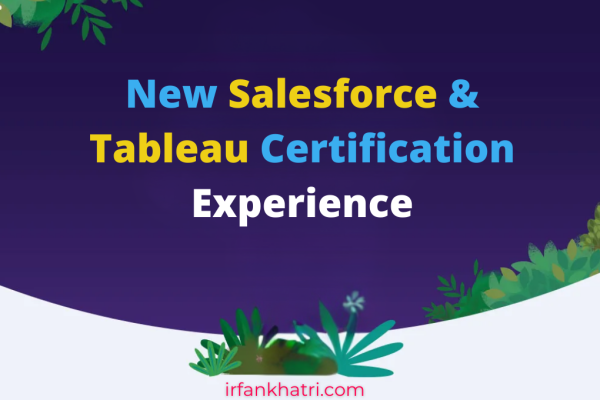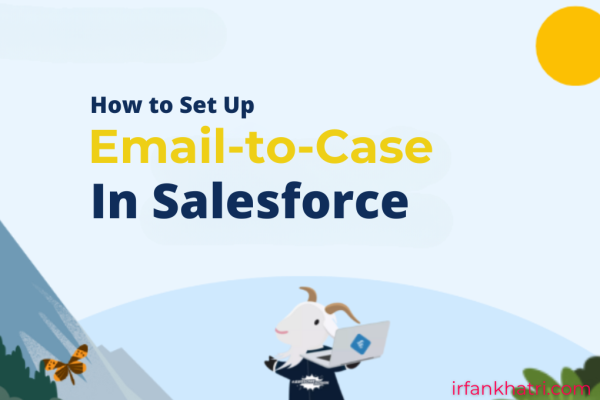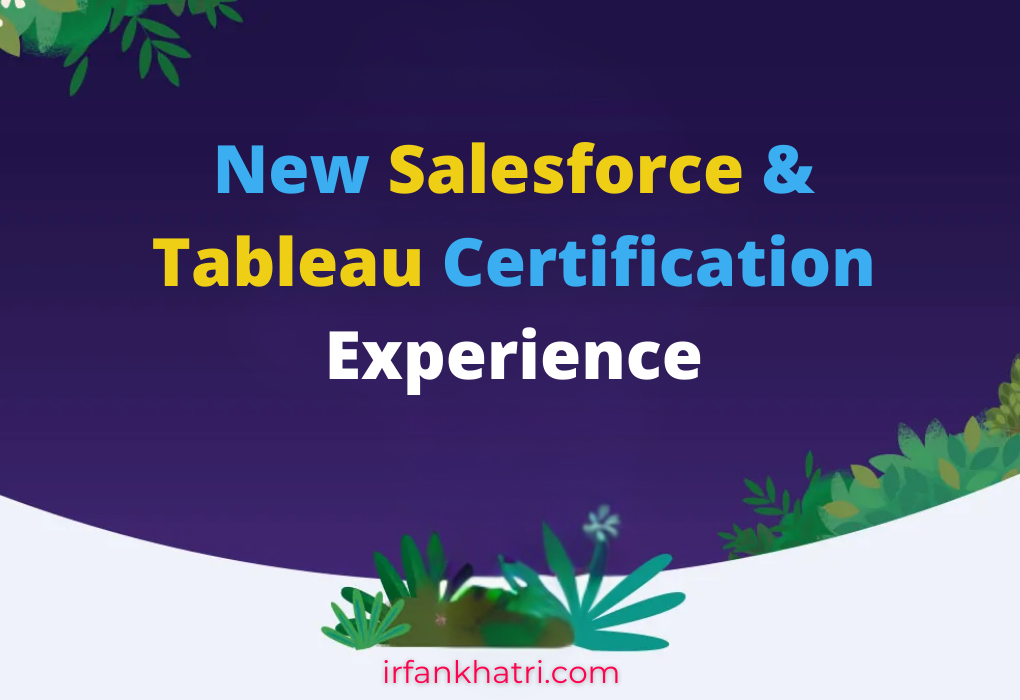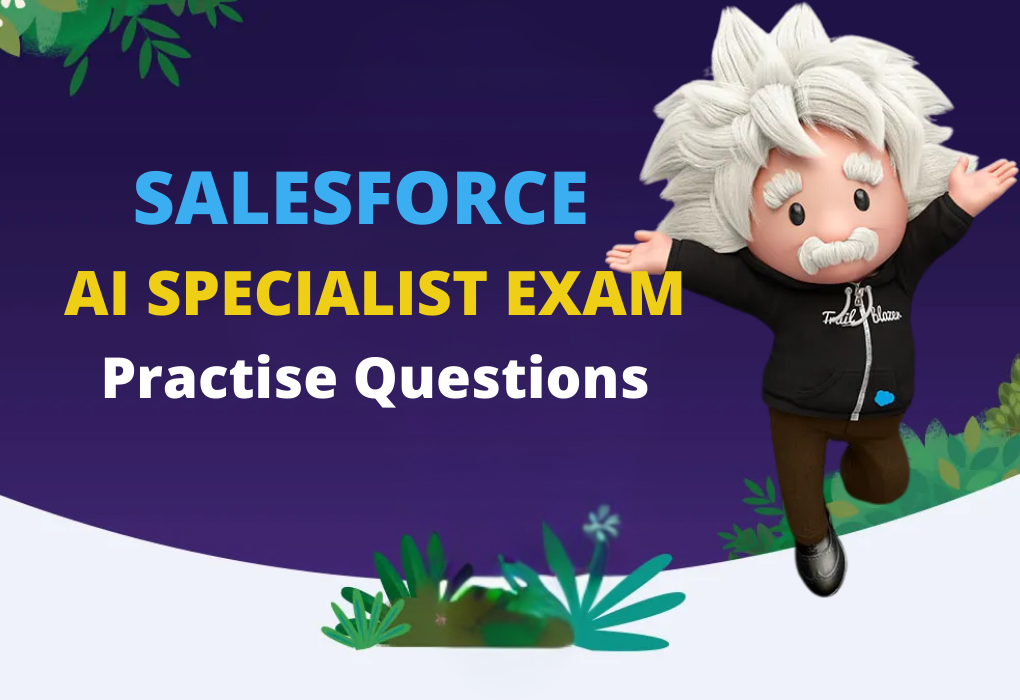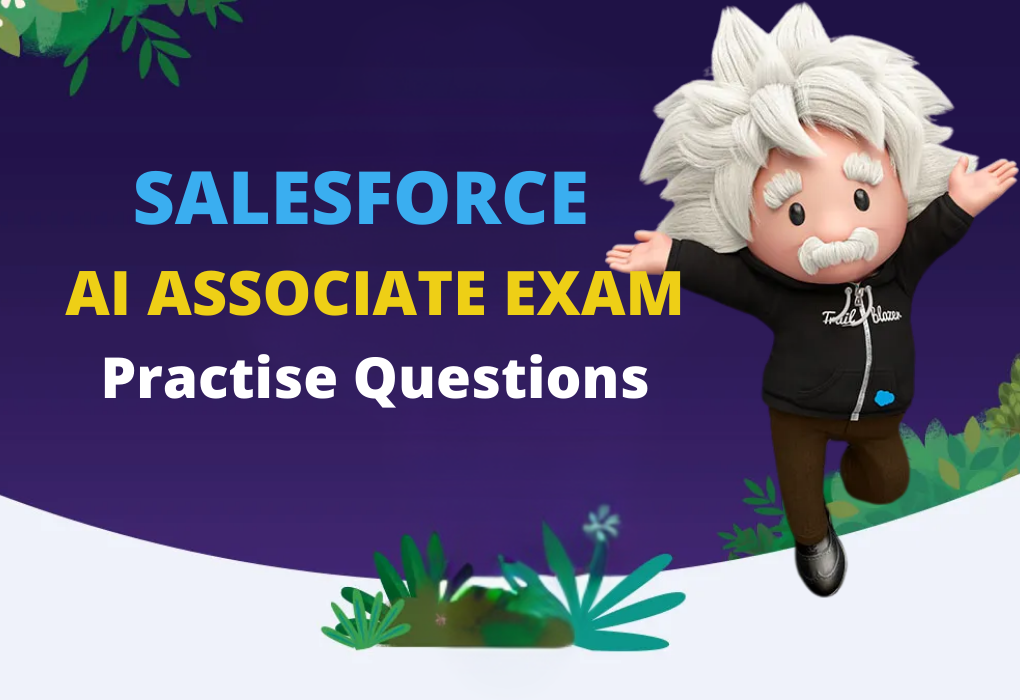
Free Salesforce Certified AI Associate Practice Questions
Are you preparing for the Salesforce Certified AI Associate exam? To succeed, you need a solid understanding of Salesforce’s AI tools, including Einstein, and how they integrate with business processes. In order to help you achieve this, we’ve put together a collection of free practice questions designed to familiarize you with the exam format and test your knowledge of Salesforce AI capabilities. By going through these questions, you’ll get a clearer idea of what to expect and gain confidence in your ability to tackle real-world Salesforce AI challenges. So, let’s dive in and use this opportunity to sharpen your skills, ultimately increasing your chances of certification success!
Question 1: Which of the following is the main purpose of using predictive analytics in Salesforce?
A) To analyze historical data and predict future outcomes.
B) To visualize data in real-time
C) To enhance customer engagement with personalized messages
Show Answer
A) To analyze historical data and predict future outcomes
Explanation: Predictive analytics uses historical data, statistical algorithms, and machine learning techniques to predict future outcomes. In Salesforce, it helps businesses forecast sales, customer behavior, and other key metrics.
Question 2: How does computer vision benefit Salesforce users?
A) By recognizing and analyzing images or videos for actionable insights
B) By processing text data for sentiment analysis
C) By predicting future customer behaviors
Show Answer
A) By recognizing and analyzing images or videos for actionable insights
Explanation: Computer vision is used to process and interpret visual information such as images or videos. In Salesforce, this could be applied for things like automatically recognizing product images or scanning documents for relevant data.
Question 3: What role does Natural Language Processing (NLP) play in Salesforce?
A) It translates customer feedback into actionable insights
B) It automates customer support using chatbots
C) It predicts future trends using historical data
Show Answer
B) It automates customer support using chatbots
Explanation: NLP allows computers to understand, interpret, and generate human language. In Salesforce, NLP can automate responses in customer support chatbots and analyze customer sentiment in communications.
Question 4: What does engagement scoring in Salesforce help measure?
A) The number of customers contacting support
B) The level of interaction a customer has with your brand
C) The total revenue generated from customer interactions
Show Answer
B) The level of interaction a customer has with your brand
Explanation: Engagement scoring helps track how engaged a customer is with your brand. Specifically, it is based on factors like website visits, email opens, social media interactions, etc., to prioritize leads and tailor marketing efforts.
Question 5: Which of the following is a key feature of deep learning in Salesforce?
A) Automatically creating dashboards from data
B) Learning from large datasets to make accurate predictions
C) Collecting feedback from users to improve CRM performance
Show Answer
B) Learning from large datasets to make accurate predictions
Explanation: Deep learning uses neural networks to learn from vast amounts of data. In Salesforce, users, therefore, utilize it to identify patterns, automate decision-making processes, and improve predictions based on large datasets.
Question 6: Which of these activities can machine learning perform in Salesforce?
A) Automate the creation of customer profiles
B) Manage marketing campaigns manually
C) Provide predictive insights based on data analysis
Show Answer
C) Provide predictive insights based on data analysis
Explanation: Machine learning in Salesforce helps analyze past data and generate predictions about customer behavior, sales forecasts, and other important metrics. As a result, it improves decision-making and automation.
Question 7: What is a common application of generative AI in Salesforce?
A) Generating personalized email content for customers
B) Analyzing customer sentiment in real-time
C) Detecting security breaches within Salesforce data
Show Answer
A) Generating personalized email content for customers
Explanation: Generative AI can create content based on data inputs, such as generating personalized emails or messages for customers. This helps with customer engagement by tailoring communication.
Question 8: In Salesforce, which type of algorithm would you use to segment customers into different groups?
A) Decision tree algorithm
B) Regression algorithm
C) Clustering algorithm
Show Answer
C) Clustering algorithm
Explanation: Clustering algorithms group similar data points together. Therefore, in Salesforce, you can use this to segment customers based on behaviors, preferences, or demographics, allowing for targeted marketing efforts.
Question 9: How does a neural network enhance Salesforce’s functionality?
A) It generates real-time customer support responses.
B) It simulates human decision-making to predict customer outcomes.
C) It tracks and manages customer interactions.
Show Answer
B) It simulates human decision-making to predict customer outcomes
Explanation: Neural networks, which are part of deep learning models, simulate human brain functions to make predictions or classifications. As a result, in Salesforce, you use them for tasks like predicting customer churn or segmenting leads based on behaviors.
Question 10: What is the main purpose of Einstein Lead Scoring in Salesforce?
A) To categorize leads based on their potential value.
B) To automate the lead generation process.
C) To enhance customer engagement via automated emails.
Show Answer
A) To categorize leads based on their potential value
Explanation: Einstein Lead Scoring uses AI to analyze historical data and behavior patterns to score leads based on their likelihood of converting into customers. As a result, it helps sales teams prioritize high-value leads.
Question 11: Why does Salesforce emphasize data quality?
A) To improve the aesthetic design of dashboards
B) To increase the storage capacity of the Salesforce platform
C) To ensure accurate sales forecasting and decision-making
Show Answer
C) To ensure accurate sales forecasting and decision-making
Explanation: Data quality is crucial in Salesforce because clean, accurate data allows for reliable insights, accurate forecasting, and better decision-making. Poor data quality can lead to incorrect predictions and misinformed strategies.
Question 12: What is the primary function of GPT (Generative Pre-Trained Transformer)?
A) To generate human-like text based on a given input.
B) To analyze and visualize customer data.
C) To predict sales trends based on historical data.
Show Answer
A) To generate human-like text based on a given input
Explanation: GPT is a powerful AI model that generates human-like text based on prompts. You can use it for creating content, automating responses, and enhancing customer interactions in tools like Salesforce’s Einstein.
Question 13: What is one of the key benefits of using deep learning in Salesforce?
A) Generating manual reports for sales teams.
B) Manually segmenting customers based on demographics.
C) Automatically predicting sales opportunities from historical data.
Show Answer
C) Automatically predicting sales opportunities from historical data
Explanation: Deep learning in Salesforce allows for the automated analysis of vast datasets, identifying patterns and making predictions about future opportunities, such as predicting which leads are most likely to convert or when a customer might be ready to buy.
Question 14: What is the role of Einstein Bots in Salesforce?
A) To automate lead nurturing and follow-up emails.
B) To handle simple customer queries and escalate complex issues to agents.
C) To create sales reports based on user feedback.
Show Answer
B) To handle simple customer queries and escalate complex issues to agents
Explanation: Einstein Bots in Salesforce provide AI-powered automation for handling routine customer queries and tasks. As a result, they help reduce the workload for human agents by addressing frequently asked questions and escalating more complex issues.
Question 15: A consultant designs a new AI model for a financial services company that offers personal loans. Which variable within their proposed model might introduce unintended bias?
A) Loan Date
B) Postal Code
C) Payment Due Date
Show Answer
B) Postal Code
Explanation: Postal codes can introduce bias as they are often correlated with socioeconomic status and race. This is due to historical practices such as redlining, where certain neighborhoods were marked as hazardous, often denying access to low-cost home lending to minority groups residing in these areas.
Question 16: Which of the following core principles does Salesforce’s Trusted AI guidelines follow?
A) Ensuring that AI is used to maximize profits over all else.
B) Ensuring AI decisions are transparent, accountable, and explainable
C) Focusing AI exclusively on automation, without human oversight
Show Answer
B) Ensuring AI decisions are transparent, accountable, and explainable
Explanation: Salesforce’s Trusted AI principles emphasize transparency, accountability, and explainability in AI models. Consequently, this ensures that AI systems remain fair, ethical, and understandable to users, helping build trust and mitigate potential risks.
Question 17: What is an example of bias in AI models?
A) AI systems generating recommendations based on past user behavior
B) AI systems favoring certain demographics due to skewed training data
C) AI systems being trained with diverse datasets
Show Answer
B) AI systems favoring certain demographics due to skewed training data
Explanation: Bias in AI occurs when a model trains on data that doesn’t represent all groups, leading to biased predictions or outcomes. This happens when training data skews toward certain demographics, resulting in unfair or inaccurate decisions.
Question 18: What does “disparate impact” refer to in the context of AI?
A) The ability of AI models to treat all demographic groups equally
B) The process of correcting biased AI models
C) Unintended consequences of AI that disproportionately affect certain groups
Show Answer
C) Unintended consequences of AI that disproportionately affect certain groups
Explanation: Disparate impact occurs when AI models, even if they are neutral, have a disproportionate negative effect on specific groups. For example, an AI tool might inadvertently disadvantage certain populations without intentional bias, which can lead to unfair outcomes.
Question 19: What is the purpose of a “premortem” in AI development?
A) To assess the potential risks and issues before a project is launched
B) To analyze the performance of an AI model after deployment
C) To celebrate the successful implementation of an AI system
Show Answer
A) To assess the potential risks and issues before a project is launched
Explanation: AI teams use a premortem strategy to identify potential problems or risks before launching an AI system. By imagining what could go wrong, teams can proactively address issues and improve the model’s robustness and fairness.
Question 20: What role does data play in AI models?
A) Data is only used for testing AI models.
B) Data is only used for validating AI models.
C) Data is used for training and testing AI models.
Show Answer
C) Data is used for training and testing AI models.
Explanation: You use training data to teach the AI model how to make predictions or decisions, while you use testing data to evaluate the model’s performance and accuracy.
Question 21: Which data quality dimension refers to the frequency and timeliness of data updates?
A) Data Source
B) Data Freshness
C) Data Leakage
Show Answer
B) Data Freshness
Explanation: Data freshness refers to how up to date or current the data is, which includes the frequency and timeliness of data updates.
Question 22: What is the primary function of Einstein Discovery in Salesforce?
A) To create predictive models with no coding required
B) To collect raw data for analysis
C) To automate marketing campaigns based on customer preferences
Show Answer
A) To create predictive models with no coding required
Explanation: Einstein Discovery is a tool that uses statistical modeling and supervised machine learning to provide predictive insights in a no-code environment. As a result, it helps businesses quickly iterate on models and derive meaningful insights from their data, all without the need for coding expertise.
Question 23: In the context of Salesforce, what does “prediction” typically refer to?
A) A historical analysis of past events
B) A random guess about future outcomes based on intuition
C) A value derived from a model that forecasts a future event or outcome
Show Answer
C) A value derived from a model that forecasts a future event or outcome
Explanation: Prediction in Salesforce involves the use of models to generate values that represent potential future outcomes. These predictions are based on historical data and are used to help businesses anticipate future events, such as customer behavior or sales performance.
Question 24: What is “data leakage” or “hindsight bias” in predictive modeling?
A) When historical data is not included in a model
B) When variables used in the model are known only after the event being predicted
C) When irrelevant data is removed from the model
Show Answer
B) When variables used in the model are known only after the event being predicted
Explanation: Data leakage (or hindsight bias) occurs when variables that are only known after the event of interest are used in the predictive model. As a result, this leads to unrealistic and overly optimistic results because the model is using information it would not have had access to at the time of the prediction.
Question 25: What does “data insights” refer to in Salesforce?
A) The raw data collected for analysis
B) The findings generated from data analysis, often using tools like Einstein Discovery
C) The automatic storage of customer data in Salesforce
Show Answer
B) The findings generated from data analysis, often using tools like Einstein Discovery
Explanation: Data insights refer to the meaningful findings derived from thorough data analysis, often powered by tools like Einstein Discovery. Specifically, these insights can reveal trends, patterns, or opportunities within the data, which, in turn, help businesses make informed decisions.
Conclusion
To conclude, practicing with these Salesforce Certified AI Associate questions is a valuable step toward mastering the core concepts of Salesforce AI. Not only will understanding tools like Einstein, Einstein Vision, Einstein Discovery, and other AI-powered features give you the technical know-how, but it will also prepare you for real-world applications in business. By reviewing these questions and thoroughly grasping the explanations, you will equip yourself to pass the exam and earn your Salesforce AI Associate certification. Ultimately, with diligent preparation and the right mindset, success is within reach. Best of luck on your journey to becoming a Salesforce-certified AI expert—your future in AI-driven business solutions awaits!
Salesforce Certified AI Associate Exam Study Material
- Salesforce Certified AI Associate Exam Guide
- Salesforce AI Associate Certification Preparation
- Salesforce AI Associate Exam Overview
- Prepare for Your Salesforce AI Associate Credential
- Salesforce AI Associate FAQ

